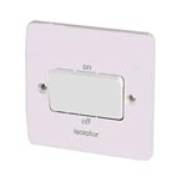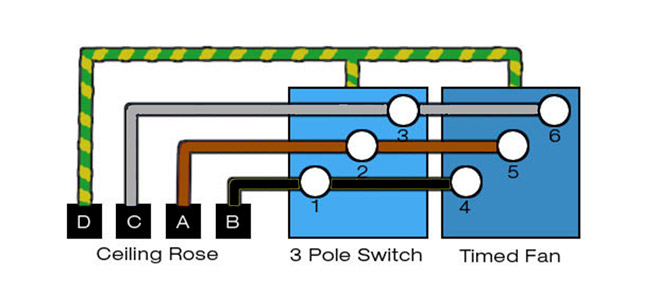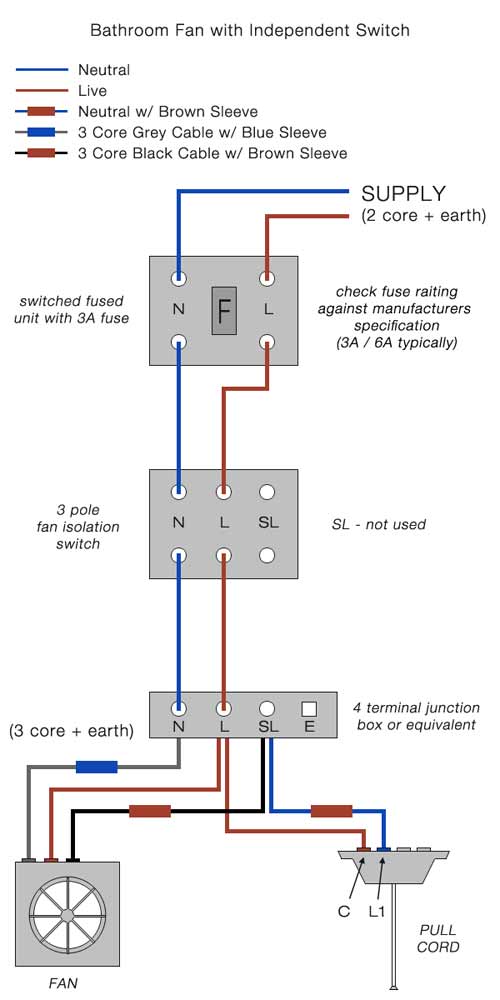How To Install Timer Switch For Bathroom Fan
Timed Fan – How to Wire a Bathroom Extractor Fan with a Timer to an Existing Light Switch or Install a new Independent Switch
Connecting a timed fan unit - how to wire in a new bathroom extractor fan with timer to an existing light switch or new independent switch. Use this clear wiring diagram of how to connect up your timed fan to ensure you install your timer fan successfully.
Warning: To complete electrical works you must comply with Electrical Regulations – Click here for more information.
Wiring an Extractor Fan With a Timed Switch That's Turned on by Existing Light Switch
Extractor Fans with an integral timer or timed switch need a 3 core and earth supply to allow the unit to run on after a light is switched off.
It must also be possible to isolate the fan by means of a pull switch inside the bathroom, or a fan isolation (3 pole) switch outside of the bathroom.
Before attempting connecting up a timed fan or any other electrical connection, please ensure all circuits are off at the mains.

Isolation switch for use in bathrooms and special areas for isolating circuits
Installing a Timed Fan Extractor
The Isolation switch must be on a pull cord inside a bathroom or as in the diagram above, a switch on the outside. Which ever one you are using, the wiring itself should be the same.
The wiring diagram below shows the wiring setup you need to connect your new timed fan to your existing light circuit ceiling rose so that when the ligh is turned on, so is the fan.

Diagram showing wiring method for a timed fan
- D = Earth Connection = To all units…This wire should be sleeved in a green/yellow earth sleeve
- C = Neutral Connection
- B = Permanent Live Connection
- A = Switched Live Connection
Wiring an Extractor Fan With an Independent Switch (not turned on by the light switch)
As with the option above for connecting to the existing light switch, before you start any wiring, make sure that the power is off to the circuit you are working on!!
This wiring diagram shows an easy to follow configuration for a bathroom extractor fan fitted with a timer, that's not going to be turned on by the existing light switch. Instead, we are going to install a new switch that will turn teh fan on and off.
There are other ways to achieve this where the junction box connections are housed within the 3-pole isolation switch, but that is more complicated to explain and increases the chances of someting going wrong.
However, using the method explained below, each stage of the installation can be easily followed and easily checked for errors or problems in the future with minimal risk of confusion.
The Minimum cable size for fans like this is 1.0mm. It is acceptable to use 1.5mm too, anything larger is still safe but unnecessary and will prove more difficult to work with.
Cable types required for the timer fan above are 2 core (twin) and earth. Here, we will be using 3 core and earth. With this in mind, if your fan does not have a timer you will not need to use 3 core cable to connect it; simple 2 core and earth is all that would be required throughout.

Diagram showing wiring method for an independently switched extractor fan
Installing the Switched Fan
The supply for this can be taken from most existing circuits providing the switched-fused-unit (SFU) is present at the start of the installation and appropriately fused to protect the sub-circuit cabling and accessories.
Typically 3A or 5A for a fan installation of this nature is sufficient, but be sure to check the manufacturers specifications for details.
From the switch-fused-unit the installation must then have a 3 pole isolation switch that provides at least 3mm of separation on ALL live conductors when the switch is off.
In this case, the switch live (SL) connection is not used but it is recommended that a 3-pole switch is still fitted as it would allow the circuit to be reconfigured to work with the light switch in future if desired.
The 3 pole switch ensures complete disconnection of supply to the fan so that maintenance can be carried out safely, without the need for a qualified electrician to disconnect the wiring (N.B. if you are in anyway unsure of how to carry out routine maintenance/cleaning on the fan, you should always seek the advice of a qualified electrician).
From the 3-pole isolator, the next stage is to connect the supply, switch and the fan together in a junction box to enable the independent pull-cord to trigger the fan, and allow it to run on, in accordance with the timer setting when the fan is switched off.
A 4-termial junction box is required, and is wired similarly to a ceiling rose or light junction box, utilising connections for earth, neutral, (permanent) live and a switch-live.
Firstly the supply from the 3-pole isolator switch should be connected in to the junction box (L, N and E), then the fan should be connected using 3 core and earth cable (depending on the model the earth may not be required), with the extra cable being used as the switch-live (SL).
Due to the colours of 3 core cable (brown, grey and black) certain conductors will need an appropriate blue or brown sleeve over them, to denote their use within the circuit (see diagrams below).
We recommend using the brown cable for the permanent live (L), the grey cable (sleeved blue) for the neutral (N) and the black cable (sleeved brown) for the switch-live (SL).
Finally, connect the pull-cord into the junction box using normal 2 core cabling as you would any other light switch, ensuring the brown is connected to the permanent live terminal in the junction box and the common (C) in the switch, and the blue cable (sleeved brown as it is not being used as a neutral but as a live conductor) is connected to the SL terminal in the junction box and L1 in the switch.
Remember that all earths need to be connected together within each enclosure in the circuit.
You should also note that the installation of a mechanical ventilation system in a special location (e.g. a bathroom) may require building control notification and may require checking and signing-off by a qualified and registered electrician. For more information, see the NICEIC notes here.
For regulations governing heights of sockets etc, please see our Socket Height project page.
You might be interested to go to our video section on installing ceiling fans to watch a film on "ceiling fan installation".
All project content written and produced by , founder of DIY Doctor and industry expert in building technology.
How To Install Timer Switch For Bathroom Fan
Source: https://www.diydoctor.org.uk/projects/timed_fan_unit.htm







Tidak ada komentar:
Posting Komentar